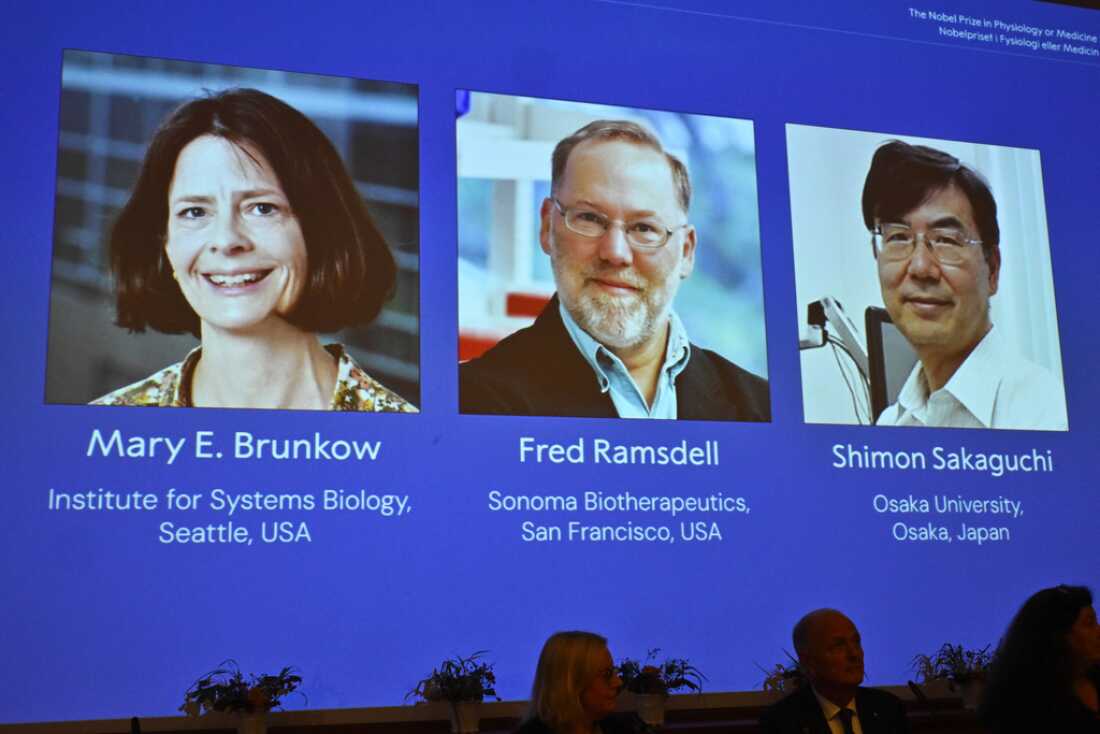
A display screen exhibiting the pictures of Mary E Brunkow, Fred Ramsdell and Shimon Sakaguchi, who on Monday have been awarded the Nobel Prize in Drugs or Physiology on the Nobel Meeting of the Karolinska Institutet in Stockholm, Sweden.
Claudio Bresciani/TT Information Company
conceal caption
toggle caption
Claudio Bresciani/TT Information Company
STOCKHOLM — Mary E. Brunkow, Fred Ramsdell and Shimon Sakaguchi received the Nobel Prize in drugs on Monday for his or her discoveries regarding peripheral immune tolerance.
Brunkow, 64, is a senior program supervisor on the Institute for Methods Biology in Seattle. Ramsdell, 64, is a scientific adviser for Sonoma Biotherapeutics in San Francisco. Sakaguchi, 74, is a distinguished professor on the Immunology Frontier Analysis Middle at Osaka College in Japan.
The immune system has many overlapping programs to detect and combat micro organism, viruses and different unhealthy actors. Key immune warriors resembling T cells get skilled on how you can spot unhealthy actors. If some as an alternative go awry in a means that may set off autoimmune ailments, they’re alleged to be eradicated within the thymus — a course of referred to as central tolerance.
The Nobel winners unraveled a further means the physique retains the system in examine.

The Nobel Committee stated it began with Sakaguchi’s discovery in 1995 of a beforehand unknown T cell subtype now often called regulatory T cells or T-regs.
Then in 2001, Brunkow and Ramsdell found a perpetrator mutation in a gene named Foxp3, a gene that additionally performs a task in a uncommon human autoimmune illness.
The Nobel Committee stated two years later, Sakaguchi linked the discoveries to point out that the Foxp3 gene controls the event of these T-regs — which in flip act as a safety guard to seek out and curb different types of T cells that overreact.
The work opened a brand new discipline of immunology, stated Karolinska Institute rheumatology professor Marie Wahren-Herlenius. Researchers around the globe now are working to make use of regulatory T cells to develop remedies for autoimmune ailments and most cancers.
“Their discoveries have been decisive for our understanding of how the immune system capabilities and why we don’t all develop severe autoimmune ailments,” stated Olle Kämpe, chair of the Nobel Committee.
Thomas Perlmann, Secretary-Normal of the Nobel Committee, stated he was solely in a position to attain Sakaguchi by telephone Monday morning.
“I received maintain of him at his lab and he sounded extremely grateful, expressed that it was a unbelievable honor. He was fairly taken by the information,” Perlmann stated. He added that he left voicemails for Brunkow and Ramsdell.
The award is the primary of the 2025 Nobel Prize bulletins and was introduced by a panel on the Karolinska Institute in Stockholm.

Final yr’s prize was shared by People Victor Ambros and Gary Ruvkun for his or her discovery of microRNA, tiny bits of genetic materials that function on and off switches inside cells that assist management what the cells do and after they do it.
Nobel bulletins proceed with the physics prize on Tuesday, chemistry on Wednesday and literature on Thursday. The Nobel Peace Prize shall be introduced Friday and the Nobel Memorial Prize in economics Oct. 13.
The award ceremony shall be held Dec. 10, the anniversary of the dying of Alfred Nobel, who based the prizes. Nobel was a rich Swedish industrialist and the inventor of dynamite. He died in 1896.

